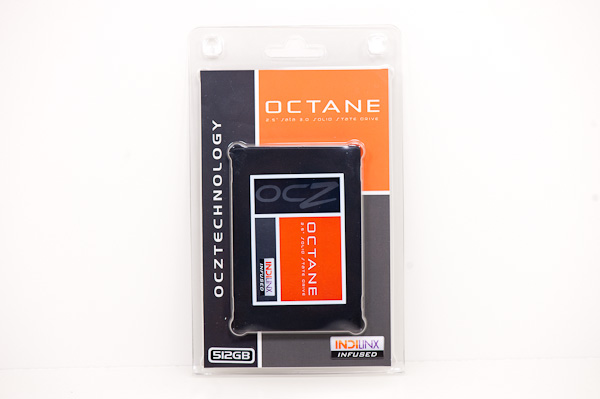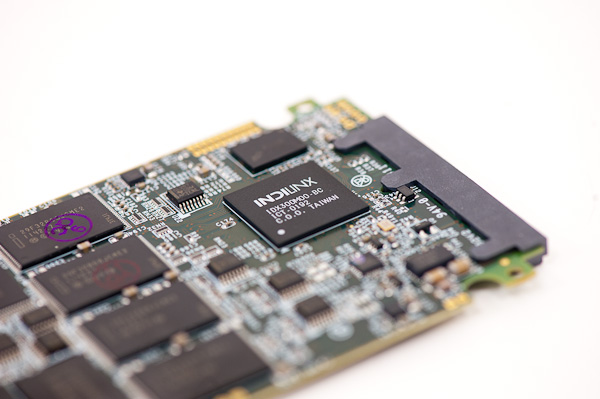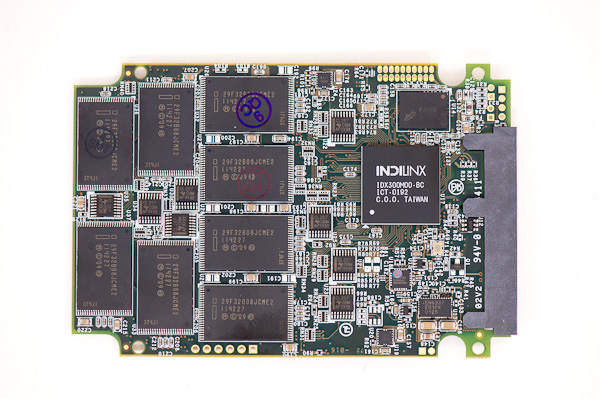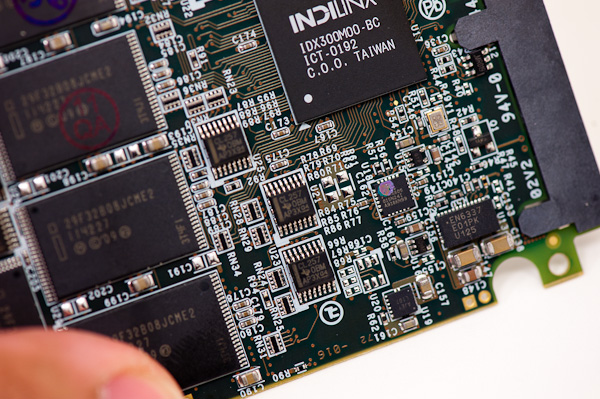The OCZ Octane Review (512GB)
by Anand Lal Shimpi on November 23, 2011 12:00 PM ESTI have to hand it to OCZ's CEO, Ryan Petersen, I never thought he'd turn the company around in the way that he did. When I first met Ryan around a decade ago, he wanted to know why I wouldn't allow him to advertise OCZ on AnandTech. The company at that time had an extremely bad reputation. It was among the worst I'd ever seen. It was so bad that not only would we not review their products (memory, at the time) but I wouldn't allow OCZ ads to run on the site. Although all advertising on AnandTech is handled through a third party, I still have the ultimate say on what ends up on the site. Back then, OCZ wasn't allowed.
Having just taken over the company, Ryan was eager to know what he had to change to fix OCZ's reputation. I gave him a long list of issues to address. Most of my suggestions were obvious, just to go above and beyond the call of duty in taking care of his customers and our readers. He agreed to do everything on the list, with one exception. I told him that if he really wanted to succeed, he needed to abandon the OCZ name and start fresh. He told me that he didn't believe it was necessary. We agreed to disagree.
I remember leaving that meeting thinking that Ryan didn't stand a chance. Memory companies were a dime a dozen. Differentiation was bordering on impossible. Having to overcome a bad reputation on top of that didn't make things any easier.
Ryan is headstrong. He'll sow a bunch of seed with the hopes of seeing just one blade of grass grow. I consider myself an optimist, but he's a different breed of one. He's had his share of failures over the years. Remember the OCZ brain mouse? The foray into notebook PCs? No one ever succeeded without trying.
Since then OCZ has abandoned memory altogether. It focuses on two product lines: power supplies and SSDs, the latter making up the bulk of its revenue. And earlier this year, OCZ bought one of the first high-performance SSD controller manufacturers - Indilinx.
OCZ's strategy there didn't make sense to me. I knew Ryan wanted to buy SandForce, but SF was too expensive. I asked Ryan why bother with Indilinx if what he really wanted was SandForce? He told me that the best way to drive the price down on SF was to buy Indilinx. It didn't add up until now.
Ryan took a big risk on Indilinx. They had a promising controller in 2009 and he bought up the bulk of what they could make in exchange for exclusivity rights. OCZ made Indilinx, and Indilinx made OCZ. As Indilinx began courting more vendors, OCZ went after SandForce. As soon as a first generation controller was ready, OCZ began shifting its volume from Indilinx to SandForce. More partners stepped up to fill the gap left by OCZ, but by then no one wanted Indilinx - they wanted SandForce based drives.
Simultaneously (perhaps a result?) Indilinx's execution suffered, the stumble was irrecoverable. The value of Indilinx went down, and Ryan got the company for cheap.
I can only assume the strategy was to rinse and repeat. I had heard rumors of OCZ working on its own controller for the past two years. The Indilinx acquisition sped things up considerably. If the Indilinx solution was good enough, OCZ would shift its volume away from SandForce to its own controller. Starve SandForce and swoop back in later to buy them at a more reasonable price. Competition makes for competitive prices on both sides of the fence it seems.
Things of course didn't work out that way. OCZ took a while to get its own controller design done and it was still very dependent on SandForce. At the same time, SandForce had diversified its portfolio. Since the announcement of the Indilinx acquisition, SandForce brought on a number of new partners to sell its drives. Even Kingston signed up. Finally, LSI agreed to purchase SandForce at a number well in the range of what SF was looking to sell for.
The situation didn't play out exactly how Ryan had hoped, I'm sure. But the result actually isn't all that bad. LSI has no intentions of stopping its supply of SandForce controllers to OCZ (or other partners), and all of the work OCZ put into its own controller finally paid off. Personally, it's hard to believe that I'm writing about the company I once advised to completely abandon their brand. Furthermore, I'm not just writing about them, but I'm writing about their first in-house SSD controller. This is the Indilinx Everest:
There's not much we can tell from looking at the silkscreen on the IC, but it's the first all new SSD controller from Indilinx since 2009. Jetstream was its predecessor, but that part never made it to market.
Everest is Indilinx's first 6Gbps controller and its delivery vehicle is the OCZ Octane SSD. You'll see both 6Gbps and 3Gbps versions of the drive, although what's launching today is the 6Gbps part.
The controller features eight NAND channels, with the ability to interleave multiple requests per channel. The capacities and price breakdown are below:
| OCZ Octane Lineup | |||||||
| 1TB | 512GB | 256GB | 128GB | ||||
| NAND Type | 25nm Intel Sync MLC | 25nm Intel Sync MLC | 25nm Intel Sync MLC | 25nm Intel Sync MLC | |||
| NAND | 1TB | 512GB | 256GB | 128GB | |||
| User Capacity | 953GiB | 476GiB | 238GiB | 119GiB | |||
| Random Read Performance | Up to 45K IOPS | Up to 37K IOPS | Up to 37K IOPS | Up to 37K IOPS | |||
| Random Write Performance | Up to 19.5K IOPS | Up to 16K IOPS | Up to 12K IOPS | Up to 7.7K IOPS | |||
| Sequential Read Performance | Up to 560 MB/s | Up to 535 MB/s | Up to 535 MB/s | Up to 535 MB/s | |||
| Sequential Write Performance | Up to 400 MB/s | Up to 400 MB/s | Up to 270 MB/s | Up to 170 MB/s | |||
| MSRP | TBD | $879.99 | $369.99 | $199.99 | |||
If these MSRPs are accurate, the Octane will be price competitive with Crucial's m4 and Samsung's SSD 830. I've learned not to trust early MSRPs when it comes to SSDs so we'll have to just wait and see. I think it's safe to say that with OCZ making the controller, we should see lower prices than OCZ's SandForce based drives. Ultimately SSDs are gated by the price of the NAND, which OCZ's Indilinx acquisition does nothing for.
The 6Gbps drive uses Intel 25nm 2-bit-per-cell MLC synchronous NAND, similar to what you'd find in a Vertex 3. OCZ sent us a 512GB version with sixteen NAND packages and four 8GB die per package. We typically don't see any interleaving benefits beyond two die per package, so I'd expect similar performance between the 512GB drive and the 256GB version (despite the significant difference in specs). Spare area is pretty standard at around 7% of the drive's total NAND.
The Octane PCB is interesting to look at. While OCZ has a history of building its own PCBs, this is the first time that we have an SSD where both the PCB and controller are made by OCZ. The controller-side of the Octane PCB is home to eight TI muxes. OCZ wouldn't tell me their purpose, but I suspect it has to do with enabling interleaving across all of the available NAND packages. With only eight channels directly connected to the controller, accessing more than eight packages will inevitably require some pipelining/interleaving. In typical SSDs I assume that the muxes (switches) to juggle multiple NAND die or packages are internal to the controller. My guess is that OCZ moved them external with Everest, although I'm not entirely sure why. It's also possible that this is somehow related to OCZ's ability to deliver a 1TB version of the drive.
All Octane drives will have a 512MB DRAM cache split into two 256MB chips. OCZ's experience in buying DRAM in bulk from its days as a memory vendor likely comes in handy with securing such a large amount of memory per drive. The amount of cache in use will depend on the capacity of the drive. Larger drives have more LBAs to map to NAND pages, and thus require larger page mapping tables.
OCZ is clearly storing user data in the Octane's on-board DRAM (hence the large size). The verdict isn't out on whether or not this is a good idea. Intel prides itself on not storing any user data in DRAM (only in on-chip caches), while SandForce's technology negates the need for any external DRAMs at all. On the other hand, the Marvell based solutions (e.g. Crucial m4) or Samsung's own controller both keep user data in on-board DRAM. Switching between architectures requires a lot of firmware work and as long as performance can be maintained, I see no reason to choose one over the other. There's always the risk of power related data loss, but that's more of a concern for enterprise customers.
OCZ sent along this block diagram of the Everest controller which indicates there's an AES encryption engine on-chip:

I couldn't get a straight answer as to whether data stored to NAND was encrypted in real time on the Octane or not. I'm going to assume that hardware encryption isn't working until I hear otherwise.
The Octane comes with OCZ's usual toolbox for secure erasing/updating firmware. Both of those processes are very simple thanks to the utility. Unfortunately OCZ is still unable to get the toolbox working if you have Intel's RST driver installed, which significantly diminishes the usability of the software.
Testing OCZ's Octane proved flawless in the short period of time I've had with the drive. That's not saying much other than there's no obvious firmware issues with the drive. The Octane will ship with firmware revision 1315, which is the same firmware revision I tested with.
The Test
| CPU |
Intel Core i7 2600K running at 3.4GHz (Turbo & EIST Disabled) - for AT SB 2011, AS SSD & ATTO |
| Motherboard: |
Intel DH67BL Motherboard |
| Chipset: |
Intel H67 |
| Chipset Drivers: |
Intel 9.1.1.1015 + Intel RST 10.2 |
| Memory: | Corsair Vengeance DDR3-1333 2 x 2GB (7-7-7-20) |
| Video Card: | eVGA GeForce GTX 285 |
| Video Drivers: | NVIDIA ForceWare 190.38 64-bit |
| Desktop Resolution: | 1920 x 1200 |
| OS: | Windows 7 x64 |



























75 Comments
View All Comments
Flashfir - Wednesday, November 23, 2011 - link
A little correction to your claim that OCZ is becoming jack of all trades, practically failure at all of them.Almost ALL of OCZ new lines of PSUs have been garnering really great reviews over reputable review sites like Jonnyguru and Hardwaresecrets. Personally I'm running an OCZ StealthXStream II 600w and I did my review searching, seemed good, it's running my rig excellently. 80+ Cert which actually meets bronze level!
Newest lines: ZX, Z, ZT, ZS series. I recall seeing ZS reviews, ZX reviews and ZT reviews all glowing, >9/10 ratings on Jonnyguru!
PSUs doing well, their SSD lines are suffering granted. The particular Vertex Plus line got crippled by data corruption issues when used with SATA I, instead of Sata II or III aka, lower than Sata 3GB/S standard.
They didn't loudly warn people about it nor did they loudly advertise the fix which was included in the 3.55 firmware update. I helped my roommate get one and it works great but I had to research and double check to see if all the 50%+ negative reviews on NewEgg were because of a controllable issue. It was true! And now his netbook is lightning fast.
Beenthere - Wednesday, November 23, 2011 - link
Just because of late OCZ's PSUs have improved, doesn't mean that they have resolved their QC/design issues any more than fixing one SandForce BSOD issues means SSDs are now free of reliability and compatibility issues. I just call it like it is and OCZ has and continues to have a very checkered history on product quality.Corsair has also had issues with their PSUs, SSDs and closed loop coolers. This is what happens when companies rush crap out the door for quick profits without doing proper qualification of the goods. As long as "enthusiasts" buy this half-baked crap and make these companies huge profits, that's what they will continue to deliver - crap.
Flashfir - Wednesday, November 23, 2011 - link
True. Everything you say is true. You know how emphasizing the bad without talking about anything good tends to give people the wrong ideas about how things really are.If OCZ's PSUs continue to be good from here on out, then their past is still checkered but they've spent enough effort to show they're good. Which we're seeing if they will do.
It's not about being right or wrong but whether or not if people who don't know much who read in can really get the same sense of "it as it really is". I wanted to correct you a little bit to clarify that PSU lines can possibly be improving.
Beenthere - Wednesday, November 23, 2011 - link
To be perfectly fair OCZ would not be at the top of my list for any product at the moment. Maybe five years down the road they will be selling reliable, trouble-free products, but right now I wouldn't touch their stuff. Same goes for Corsair other than their RAM. You couldn't pay me to use a half-baked Asus mobo either. All of this stuff is rushed out the door for profit before it's ready for prime time, IME.Unfortunately the PC industry is rifle with crap products - because people are naive enough to buy them.
jleach1 - Sunday, November 27, 2011 - link
Oh yeah? My stealthxstream blew in a spectacular manner 6 months after I purchased it and it filled my whole house with that burnt electronics smell that you can never seem to get out of your nose.That combined with the nonexistent support I received for a set of DDR3 dims that required lowering the speed and upping the voltages every few months has me avoiding OCZ for the 12 months Anand spoke of at all costs.
I didn't even attempt to rma my power supply.
How many people have decided just to junk their hardware after being nickeled out of a manufacturers rebate or hounded on by ocz support for months with useless questions, I don't know. And we'll probably never know.
jimbowdang - Wednesday, November 23, 2011 - link
Great review Anand, reading your comments on passing up on this drive for use on OS X makes me wonder if those hacks that supposedly allow non-Apple SSDs to use Trim actually work. I've been using an Intel G2 160 GB SSD in my 2010 13" MBP for over a year now and I've done the hack but I've never seen any testing to confirm that it actually works. I would love to see some testing on this as real Trim support would open up a lot of SSD options for OS X.NCM - Thursday, November 24, 2011 - link
Surely you'd notice if your enabling OS X TRIM on a (non-Sandforce) SSD wasn't working, at least unless you had a quite large amount of spare capacity to start with. Even then you'd eventually start reusing storage and would see a slowdown.I think it's worth making clear that although OS X only turns on TRIM by default for Apple supplied SSDs, it's trivial to enable it for third party units. It also seems reasonable to suppose that anyone motivated to install their own SSD on a Mac would also know to do that.
We're currently running four of our Macs with SSDs, two laptops and an Xserve that I ordered that way, plus a Mac Pro that I retrofitted.
Peroxyde - Wednesday, November 23, 2011 - link
Did the new CEO also setup un-honored Mail In Rebate as a business? If so it is quite successful.geddarkstorm - Wednesday, November 30, 2011 - link
Had that happen to me with two different kingston products. Don't trust mail-in-rebate to begin with, no matter who is peddling it.krazyderek - Wednesday, November 23, 2011 - link
Would have really liked to see a throughput vs transfer size for this drive :( some of us move around large compressed movies for editing and i'd like to know how the octane fairs against the m4 in such cases.also, where is the avg access time, and max latency?? could also be good points to have about a new controller!